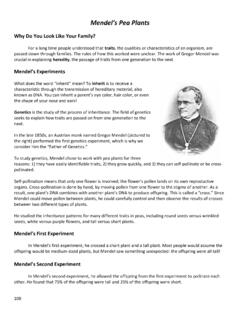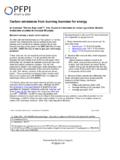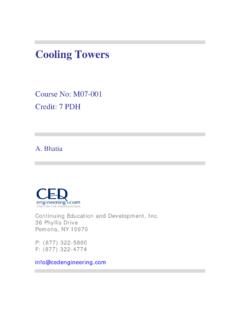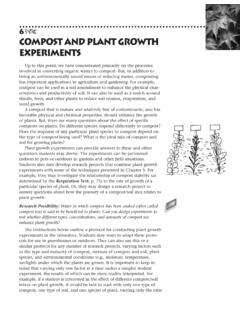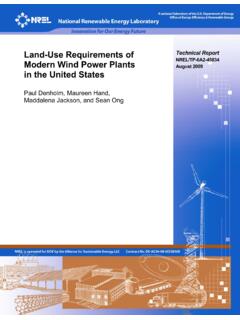Transcription of Understanding Inertial and Frequency Response of Wind ...
1 NREL is a national laboratory of the Department of Energy, Office of Energy Efficiency & Renewable Energy, operated by the Alliance for Sustainable Energy, LLC. Contract No. DE-AC36-08GO28308 Understanding Inertial and Frequency Response of Wind Power plants Preprint E. Muljadi, V. Gevorgian, and M. Singh National Renewable Energy Laboratory S. Santoso University of Texas Austin To be presented at the IEEE Symposium on Power Electronics and Machines in Wind Applications Denver, Colorado July 16-18, 2012 Conference Paper NREL/CP-5500-55335 July 2012 NOTICE The submitted manuscript has been offered by an employee of the Alliance for Sustainable Energy, LLC (Alliance), a contractor of the US Government under Contract No. DE-AC36-08GO28308. Accordingly, the US Government and Alliance retain a nonexclusive royalty-free license to publish or reproduce the published form of this contribution, or allow others to do so, for US Government purposes.
2 This report was prepared as an account of work sponsored by an agency of the United States government. Neither the United States government nor any agency thereof, nor any of their employees, makes any warranty, express or implied, or assumes any legal liability or responsibility for the accuracy, completeness, or usefulness of any information, apparatus, product, or process disclosed, or represents that its use would not infringe privately owned rights. Reference herein to any specific commercial product, process, or service by trade name, trademark, manufacturer, or otherwise does not necessarily constitute or imply its endorsement, recommendation, or favoring by the United States government or any agency thereof. The views and opinions of authors expressed herein do not necessarily state or reflect those of the United States government or any agency thereof.
3 Available electronically at Available for a processing fee to Department of Energy and its contractors, in paper, from: Department of Energy Office of Scientific and Technical Information Box 62 Oak Ridge, TN 37831-0062 phone: fax: email: Available for sale to the public, in paper, from: Department of Commerce National Technical Information Service 5285 Port Royal Road Springfield, VA 22161 phone: fax: email: online ordering: Cover Photos: (left to right) PIX 16416, PIX 17423, PIX 16560, PIX 17613, PIX 17436, PIX 17721 Printed on paper containing at least 50% wastepaper, including 10% post consumer waste. 1 Understanding Inertial and Frequency Response of Wind Power plants E. Muljadi, Fellow, IEEE, V. Gevorgian, Member, IEEE, M. Singh, Member, IEEE, and S.
4 Santoso, Senior Member, IEEE Abstract The objective of this paper is to analyze and quantify the inertia and Frequency responses of wind power plants with different wind turbine technologies (particularly those of fixed speed, variable slip with rotor-resistance controls, and variable speed with vector controls). The fundamental theory, the operating range, and the modifications needed for the wind turbine to contribute to the Inertial and primary Frequency Response during the Frequency drop will be presented in this paper. We will demonstrate practical approaches to allow variable slip and speed wind turbines to contribute inertia to the host power system grid. The approaches are based on the inclusion of Frequency error and the rate of change of Frequency signals in the torque control loop and pitch control actions for wind speeds below and above its rated value.
5 Detailed simulation models in the time domain will be conducted to demonstrate the efficacy of the approaches. Index Terms wind turbine, Inertial Response , governor Response , Frequency Response I. NOMENCLATURE WTG wind turbine generator ROCOF rate of change of Frequency DFIG double-fed induction generator H inertia constant(s) AGC automatic generation control PFR primary Frequency Response II. INTRODUCTION HE differences among turbine types are mostly based on the electrical generation parts (generator, power converter, and control algorithm) of the turbines. The strategies used to control the prime mover are generally similar. Mechanical brakes and blade pitch control are commonly used to avoid runaway conditions and keep the stresses on the mechanical components of the wind turbine generator (WTG) within the operating range of the design tolerance.
6 The pitch angle of the blades is usually controlled during high wind speeds to keep the aerodynamic power within limits; thus, the output power and rotor speed can be kept within boundary limits. Many modern wind plants have the ability to control active power output in Response to grid Frequency in ways that are important to overall grid performance [1]. M. Singh (email: V. Gevorgian (email: and E. Muljadi (email: are with the National Renewable Energy Laboratory, Golden, CO 80401 USA. S. Santoso (e-mail: is with the Department of Electrical Engineering, University of Texas, Austin, TX 78712 USA.))))
7 In the first few seconds following the loss of a large power plant, the grid Frequency starts to drop. These initial Frequency dynamics are dominated by the Inertial Response of the generators that remain online. The synchronous generators release their stored kinetic energy into the grid, reducing the initial rate of change of Frequency (ROCOF) and allowing slower governor actions to catch up and contribute to Frequency stabilization. A performance similar to conventional generators can be achieved with a wind power plant by utilizing a controlled Inertial Response [2]. Increased variable wind generation will have many impacts on the primary Frequency control actions of the power system. In [3], the lower system inertia was identified as one such impact because it would increase the requirements for primary Frequency control reserves to arrest Frequency at the same nadir following the sudden loss of generation.
8 The research community has begun to document Frequency Response implications for various independent system operators (ISOs) . A recent study for California ISO [4] examined cases with high levels of wind and solar generation. It found that reduction in system inertia because of higher levels of renewable generation will not have a significant impact on Frequency Response when compared with governor action. However, fast transient Frequency support using controlled Inertial Response from wind power will help increase the underfrequency load-shedding margin and avoid load shedding because of low frequencies. This study [4] demonstrated that the benefits of these responses can be several times greater per megawatt ( MW) than was observed for governor Response in the synchronous fleet.
9 An excellent state-of-the-art review of inertia by wind power was conducted in [5]. It demonstrated that many ISOs and regional transmission operators in different countries began recognizing the value of Inertial Response by wind power and its importance for system reliability. In particular, Red El ctria de Espa a (Spain), Hydro Quebec (Canada), Electric Reliability Council of Texas, and others in Ireland and Denmark are in different stages of implementing wind inertia requirements in their operations [5], [6]. The combined Inertial Response of a wind power plant will depend on the electrical characteristics of its individual wind turbines. Constant-speed wind turbines have different Inertial Response than synchronous generators; however, they do not intrinsically decrease the power system inertia because of their electromechanical characteristics.
10 On the other hand, the rotating mass of variable-speed wind turbines is decoupled from the grid Frequency and does not inherently exhibit an Inertial Response unless controlled for that specific purpose. T 2 An example study of Inertial Response impact on the Ireland grid from both fixed and variable-speed wind turbines was conducted in [7]. Similar work that looked into inertia comparison between fixed- and variable-speed WTGs was conducted earlier in [7]. The group of authors in [9] explained the importance of the Inertial Response by wind power and developed different Inertial control strategies. Fig. 1 illustrates the four types of WTGs, starting with Type 1 (fixed speed induction generator) through Type 4 (variable speed full-conversion system).











